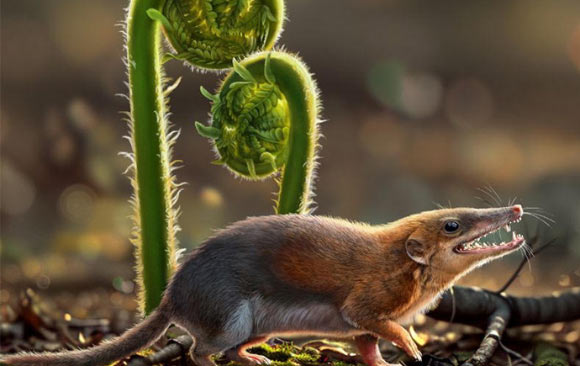Two new Jurassic species — the morganucodontan-like Dianoconodon youngi and the pseudotribosphenic shuotheriid Feredocodon chowi — offer key information about the evolutionary shift from the jaw joint bones to those of the middle ear in early mammals.
Dianoconodon youngi. Image credit: Institute of Vertebrate Paleontology and Paleoanthropology, Chinese Academy of Sciences.
Both Dianoconodon youngi and Feredocodon chowi lived in China over 150 million years ago (Jurassic period).
The type specimens of Feredocodon chowi were found at the locality of Dauhugou in the Ningchen Basin in Inner Mongolia.
The Dianoconodon youngi fossils were discovered at the Heiguopeng locality of the Lufeng Formation in Yunnan province.
The specimens show noticeable physical characteristics, suggesting a gradual change in the jaw joint’s function towards specializing in hearing.
“The significance of this discovery is that both species have mandibular middle ears, and the morganucodontan-like species have new postdentary bone structures,” said Professor Patricia Vickers-Rich, a researcher at Monash University and Museums Victoria.
“Dianoconodon youngi is losing the load-bearing function of its articular-quadrate joint, whereas Feredocodon chowi is showing characteristics suited for purely auditory function.”
The fossils offer important evidence of the transitional phases in the evolution of the mammalian middle ear.
A progressive decline in the load-bearing capacity of the main jaw joint is leading to the separation of postdentary bones from the dentary.
The findings revise prior ideas of the original state of the mammalian middle ear.
They enhance the understanding of mammaliaform development by resolving questions related to middle ear evolution in close mammal relatives.
“Studying transitional stages in evolutionary history is crucial,” Professor Vickers-Rich said.
“The fossils show incremental modifications that demonstrate the complex process of adaptation that resulted in the advanced hearing systems found in modern animals.”
The results also provide insight into how tissues such as the ossified Meckel’s cartilage helped in the shift from jaw movement to hearing ability.
Paleontologists can track the steady evolution of the middle ear ossicles by studying traits like the medial displacement of the quadrate in reference to the articular.
“Newly recognized well-preserved fossils from the Jurassic of China significantly clarify how one of the most remarkable transitions in the history of the vertebrates occurred,” said Dr. Thomas Rich, also from Monash University and Museums Victoria.
“Namely, the transformation of many of the multiple bones in the lower jaws of reptiles became tiny bones in the middle ears of mammals.”
The study appears today in the journal Nature.
_____
F. Mao et al. Fossils document evolutionary changes of jaw joint to mammalian middle ear. Nature, published online April 3, 2024; doi: 10.1038/s41586-024-07235-0
>>> Read full article>>>
Copyright for syndicated content belongs to the linked Source : Breaking Science News – https://www.sci.news/paleontology/dianoconodon-youngi-12822.html
